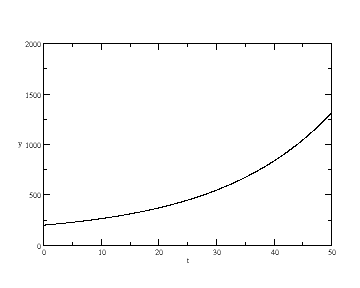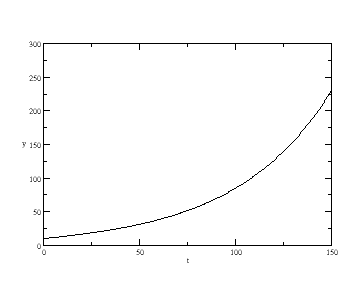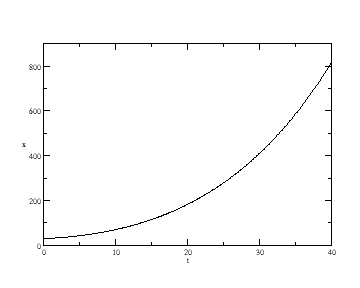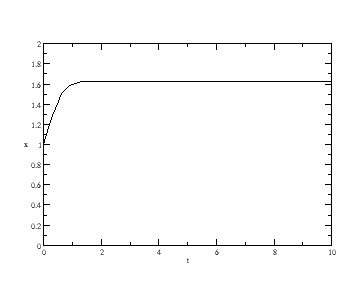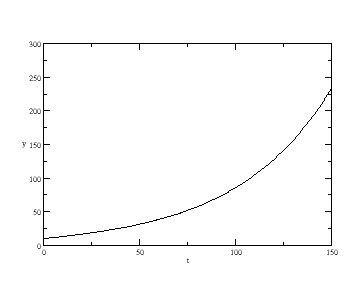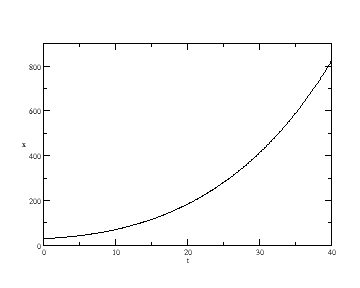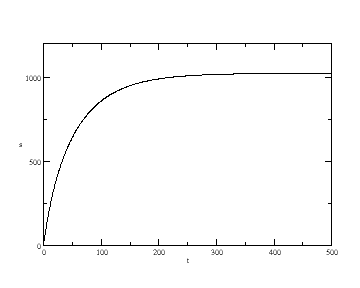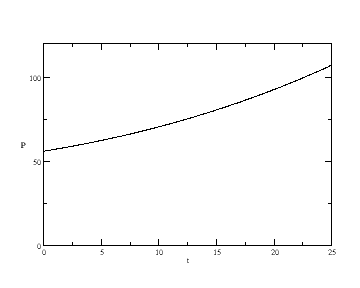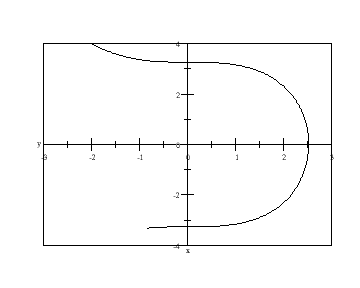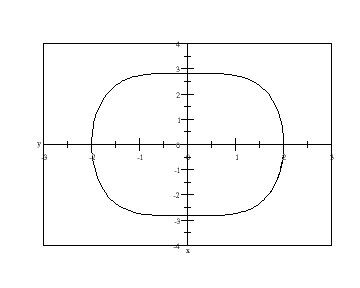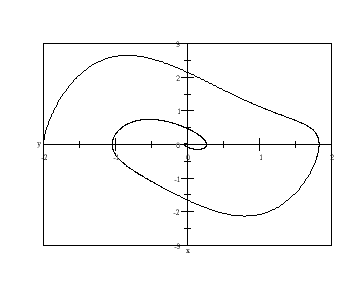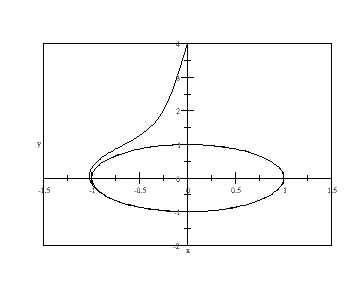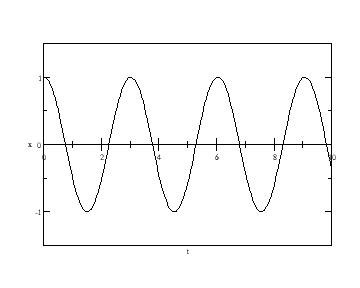User Tools
Differential Equations to Difference Equations
Answers for selected problems
Chapter 8
Section 8.1
1. (a) $ \displaystyle{x(t) = \frac{1}{3}t^3 - 2t + 3}$
(c) $ \displaystyle{y(t) = \frac{2}{3}t^{\frac{3}{2}} - \frac{11}{3}}$
3. (a) $ \displaystyle{x(t) = -16t^2 + 20t + 100}$
(b) $ \displaystyle{t = \frac{5}{8}}$ seconds
(c) $ 106.25 $ feet
(d) $ \displaystyle{t = \frac{5}{8}(1 + \sqrt{17}) = 3.2019}$ seconds, rounded to 4 decimal places
(c) Yes, the object appears to be approaching a terminal speed of $ 1024 $ feet per second.
(d) The solution, $ \displaystyle{s = \frac{1024}{c^2}}$, is the terminal speed of the object since this is the speed at which the acceleration is $ 0 $.
(c) $ 70.5 $ million
(d) During the year 2022
Section 8.2
1. (a) $ \displaystyle{x = 75e^{-0.9t}}$
(c) $ \displaystyle{y^2 = t^2 + 25}$, or $ \displaystyle{y = \sqrt{t^2 + 25}}$
(e) $ \displaystyle{x^2 = 2t - 2\log(1 + t) + 16}$, or $ \displaystyle{x = \sqrt{2t - 2\log(1 + t) + 16}}$
(g) $ \displaystyle{x = \frac{1}{1 + 4e^{-t}}}$
2. (a) $ \displaystyle{x = \frac{2x_0}{2 + x_0t^2}}$
(c) If $ x_0 > 0 $, domain $ = (-\infty, \infty) $. If $ x_0 < 0 $, domain $ \displaystyle{= \left\{t : t \ne \sqrt{-\frac{2}{x_0}}\right\}}$.
3. (a) The equation of the curve is $ ax^2 + by^2 = c $, where $ c $ is a constant. This is the equation of an ellipse, which becomes a circle if $ a = b $.
4. (a) $ \displaystyle{x = \frac{x_0}{1 - kx_0t}}$
(c) $ \displaystyle{x = \left(\frac{1}{2}kt + \sqrt{x_0}\right)^2 = \frac{1}{4}k^2t^2 + k\sqrt{x_0}t + x_0}$
(e) The slowest population growth occurs when $ 0 < b < 1 $, the most rapid when $ b > 1 $. The case $ b > 1 $ is called the doomsday model because the population goes to infinity in a finite amount of time.
5. (b) $ \displaystyle{v = \sqrt{\frac{mg}{k}}\left(\frac{1 - e^{2\sqrt{\frac{kg}{m}}t}}{1+e^{2\sqrt{\frac{kg}{m}}t}}\right) = -\sqrt{\frac{mg}{k}}\tanh\left(\sqrt{\frac{kg}{m}}t\right)}$
Section 8.3
1. (a) $ \displaystyle{x(t) = \frac{20}{9}e^{3t} - \frac{2}{3}t - \frac{2}{9}}$
(c) $ \displaystyle{y = \frac{25}{2}e^{0.4t} - \frac{15}{2}}$
(e) $ \displaystyle{x = t^3 + 3t^2}$
2. (a) $ \displaystyle{x = 1.2e^{0.015t + 0.34875(1 - e^{-0.04t})}}$
3. (b) $ \displaystyle{y = 156e^{0.02t} - 2t - 100}$
(c) $ 70.5 $ million
(d) During the year 2022
5. (b) $ \displaystyle{x = kV + V(k_0 - k)e^{-\frac{q}{V}t}}$, $ \displaystyle{\lim_{t \to \infty}x(t) = kV}$
6. (b) $ \displaystyle{x = \frac{2t}{1 + t^2}}$
(c) $ \displaystyle{x = \frac{1}{1 + e^{-t}}}$
Section 8.4
1. (a) $ \displaystyle{x = \frac{2}{3}e^t - \frac{2}{3}e^{-2t}}$
(c) $ \displaystyle{x = 2e^{-t} - e^{-2t}}$
(e) $ \displaystyle{x = e^t(10\cos(t) - 6\sin(t))}$
(g) $ \displaystyle{x = \frac{3}{4}\sin(4t)e^{-2t}}$
(i) $ \displaystyle{x = -(6 + 14t)e^{-3t}}$
3. (a) $ x(0) = 0 $: $ \displaystyle{x = \frac{1}{3}\sin(3t)e^{-t}}$
$ x(0) = -10 $: $ \displaystyle{x = -e^{-t}(10\cos(3t) + 3\sin(3t))}$
$ x(0) = 10 $: $ \displaystyle{x = e^{-t}\left(10\cos(3t) + \frac{11}{3}\sin(3t)\right)}$
(b) $ \dot{x}(0) = 0 $: $ \displaystyle{x = e^{-t}\left(10\cos(3t) + \frac{10}{3}\sin(3t)\right)}$
$ \dot{x}(0) = -5 $: $ \displaystyle{x = e^{-t}\left(10\cos(3t) + \frac{5}{3}\sin(3t)\right)}$
$ \dot{x}(0) = 5 $: $ \displaystyle{x = e^{-t}(10\cos(3t) + 5\sin(3t))}$
5. (a) $ \displaystyle{x = c_1e^t + c_2e^{-t} + c_3e^{-2t}}$
(b) $ \displaystyle{x = c_1e^{-t} + c_2te^{-t} + c_3t^2e^{-t}}$
Section 8.5
1. $ g \approx 978.9 $ centimeters per second per second
3. For $ c = 0 $, \[ x = 10\cos(t) \] and the motion is undamped. For $ c = 10 $, \[ x = \frac{20}{\sqrt{3}}e^{\frac{-t}{2}}\cos\left(\frac{\sqrt{3}}{2}t - \frac{\pi}{2}\right) \] and the motion is underdamped. For $ c = 25 $, \[ x = -\frac{10}{3}e^{-2t} + \frac{40}{3}e^{-\frac{t}{2}} \] and the motion is overdamped.
6. (a) Hint: Show that $ x $ must satisfy the equation $ \displaystyle{\ddot{x} + \frac{k}{m}x = 0}$, where $ \displaystyle{k = \frac{mg}{R}}$.
(b) $ 84.5 $ minutes
(c) $ -17,614 $ miles per hour
Section 8.6
1. (a) $ x = c_1\cos(t) + c_2\cos(t) $, $ (0, 0) $ is a center
(b) $ x = c_1e^{-t} + c_2e^{-2t} $, $ (0, 0) $ is a stable equilibrium
(c) $ x = c_1e^t + c_2e^{-t} $, $ (0, 0) $ is an unstable equilibirum
(d) $ x = e^{-t}(c_1\cos(t) + c_2\sin(t)) $, $ (0, 0) $ is a stable equilibrium
(e) $ x = e^t(c_1\cos(t) + c_2\sin(t)) $, $ (0, 0) $ is an unstable equilibrium
4. (a) Equations:
\[
\begin{align}
\dot{x} &= y \\
\dot{y} &= -x^2
\end{align}
\]
Graph of $ x(t) $: 
(c) Equations:
\[
\begin{align}
\dot{x} &= y \\
\dot{y} &= -x^3
\end{align}
\]
Graph of $ x(t) $: 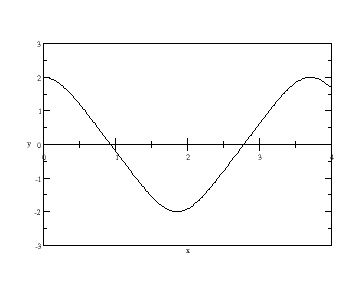
(e) Equations:
\[
\begin{align}
\dot{x} &= y \\
\dot{y} &= (x^2 - 1)y - x
\end{align}
\]
Graph of $ x(t) $: 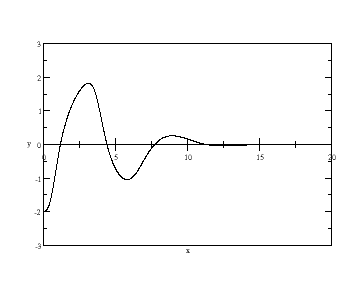
5. (a) Graph of $ x(t) $ (blue) and $ y(t) $ (red): 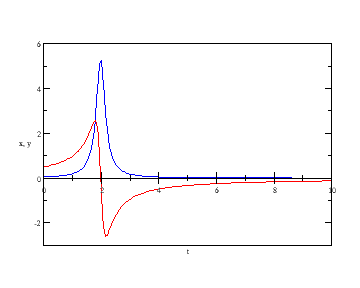
(c) Graph of $ x(t) $ (blue) and $ y(t) $ (red): 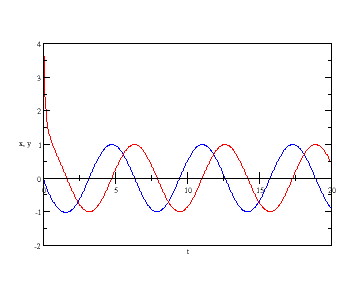
The period is approximately $ 3.00 $ seconds. The period of the linearized system is $ 2.84 $ seconds. The exact period (see Problem 2 in Section 8.5) is $ 3.03 $ seconds.
9. (a) Equations: \[ \begin{align} \dot{x} &= y \\ \dot{y} &= -\alpha y + x(1 - x^2) \end{align} \]
Stationary points: $ (-1, 0) $, $ (0, 0) $, and $ (1, 0) $
(b) $ (-1, 0) $ and $ (1, 0) $ are stable equilibrium points and $ (0, 0) $ is an unstable equilibrium point.
(c) $ (-1, 0) $, $ (0, 0) $, and $ (1, 0) $ are all unstable equilibrium points.
Section 8.7
1. (a) $ \displaystyle{x = a_0\sum_{n=0}^\infty \frac{3^nt^n}{n!} = a_0e^{3t}}$
(c) $ \displaystyle{x = a_0 + (a_0 - 1)\sum_{n=1}^\infty \frac{t^n}{n!} = 1 + (a_0 - 1)e^t}$
2. (a) For $ t $ in $ (-\infty, \infty) $, \[ x = a_0\left(1 - \frac{1}{6}t^3 + \frac{1}{180}t^6 - \cdots\right) + a_1\left(t - \frac{1}{12}t^4 + \frac{1}{504}t^7 - \cdots\right). \]
(c) For $ t $ in $ (-\infty, \infty) $, \[ x = a_0\left(1 - \frac{1}{2}t^2 + \frac{1}{8}t^4 - \cdots\right) + a_1\left(t - \frac{1}{3}t^3 + \frac{1}{15}t^5 - \cdots\right). \]
(e) For $ t $ in $ (-1, 1) $, \[ x = a_0\left(1 + \frac{1}{2}t^2 + \frac{7}{24}t^4 + \cdots\right) + a_1\left(t + \frac{1}{2}t^3 + \frac{13}{40}t^5 + \cdots\right). \]
5.
| $\mathbf{r}$ | Polynomial solution |
|---|---|
| $0$ | $ x_1(t) = 1 $ |
| $ 1 $ | $ x_2(t) = t $ |
| $ 2 $ | $ x_1(t) = 1 - 2t^2 $ |
| $ 3 $ | $ x_2(t) = t - \frac{2}{3}t^3 $ |
| $ 4 $ | $ x_1(t) = 1 - 4t^2 + \frac{4}{3}t^4 $ |
| $ 5 $ | $ x_2(t) = t - \frac{4}{3}t^3 + \frac{4}{15}t^5 $ |
7. (c) Legendre polynomials: \[ \begin{align} P_0(t) &= 1 \\ P_1(t) &= t \\ P_2(t) &= -\frac{1}{2} + \frac{3}{2}t^2 \\ P_3(t) &= -\frac{3}{2}t + \frac{5}{2}t^3 \\ P_4(t) &= \frac{3}{8} - \frac{15}{4}t^2 + \frac{35}{8}t^4 \\ P_5(t) &= \frac{15}{8}t - \frac{35}{4}t^3 +\frac{63}{8}t^5 \\ \end{align} \]

